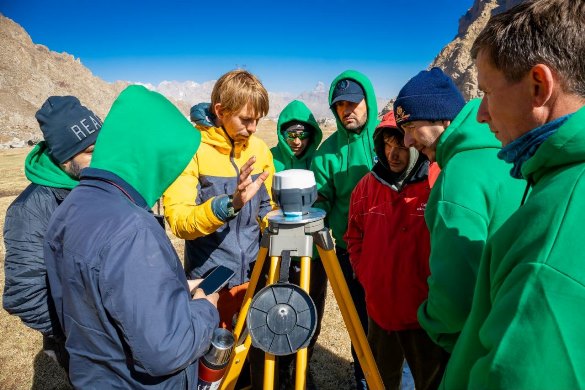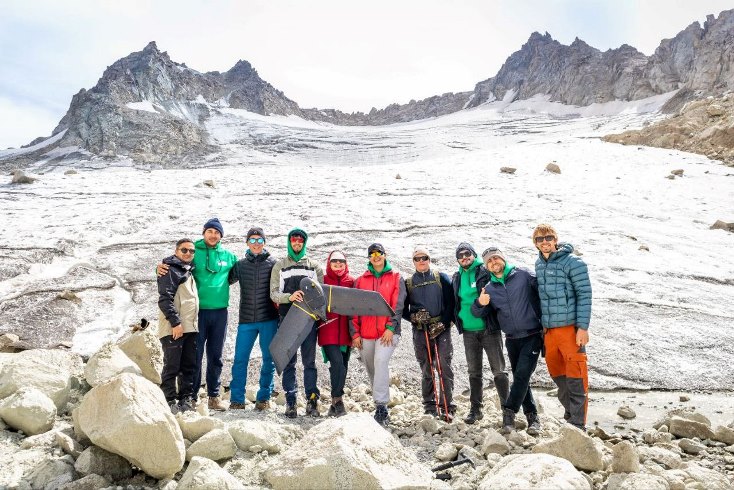The Integrated Rural Development Project/ TRIGGER, the European Union supported the second expedition to the Hydrographic Party (GGP) Glacier. The mission was conducted with the support of the Ministry of Energy and Water Resources of the Republic of Tajikistan (MEWR) in collaboration with the FutureWater Consortium and Utrecht University, including logistical support from GFA Consulting Group. The expedition focused on enhancing cryosphere monitoring and water management in the Zarafshon River Basin.
The primary goal of the expedition was to provide local experts from key water management institutions with the skills necessary to monitor glaciers and seasonal snowmelt using drone technology. It gathered 12 participants from the key local water institutions. The introduction of such modern methods is particularly critical in the context of the accelerating impacts of climate change. Given that Tajikistan’s economy and livelihoods are heavily reliant on water from glaciers and snowmelt, the shrinking of glaciers due to rising temperatures and precipitation changes is a significant concern, particularly for Central Asia’s dry agricultural seasons.

To address the complex challenges posed by climate change, collaboration between local and international institutions is essential. Therefore, the IRDP/TRIGGER is facilitating a partnership among Tajikistan’s key water management bodies, including MEWR, the Agency for Hydrometeorology under the Committee for Environmental Protection, and the Institute of Water Problems, Hydropower, and Ecology of the National Academy of Sciences. To introduce modern glacier monitoring practices, the project has engaged leading cryosphere research institutions, including FutureWater and Utrecht University from the Netherlands. Together, these institutions are strengthening Tajikistan’s capacity to monitor and manage its water resources more effectively, enabling data-driven decision-making.

“The methods introduced during the expedition marked a significant shift from traditional monitoring to more accurate and efficient data collection on glacier conditions. We learned to set up drones, conduct aerial surveys, analyze the collected data, and integrate the drone data with other sources to develop comprehensive models of glacier melt. This expedition has truly expanded our capabilities for precise glacier monitoring, which is crucial for tracking climate change”, said Sherzod Nekov, Specialist of the Zarafshon River Basin Organization.
The Zarafshon River Basin is one of Tajikistan’s most vital water sources, with glaciers and seasonal snowmelt contributing up to 80-90% of its streamflow. The GGP Glacier plays a crucial role in supplying water to Iskanderkul Lake and one of the tributaries of the Iskanderdarya River. However, climate change is having a profound impact on the glacier, which is currently losing 1 to 2 m of ice mass each year. If this trend continues, the glacier could disappear by 2035, posing a significant threat to regional water security and the livelihoods of local communities.
“The expedition to GGP highlighted the vulnerability of the cryosphere. The integration of new technology and international cooperation is vital for understanding the impact of climate change on Tajikistan’s glaciers. The upcoming Year of Glacier Preservation, hosted by the government of Tajikistan, underscores the importance of making glacier protection a top priority,” said Professor Dr. Walter Immerzeel, Director of Research at Utrecht University.

Earlier this year, in-person training sessions on glacio-hydrological modelling using the Spatial Processes in Hydrology (SPHY) model and the Water Evaluation and Planning System (WEAP) were held in Dushanbe, followed by a study tour in the Netherlands in August 2024. These efforts equipped local experts with the practical skills needed to use drone technologies for glacier and snow monitoring. The hands-on experience gained has been critical in building local capacity for informed, data-driven decision-making. These advanced modelling tools are essential for developing climate-resilient water management strategies that will be incorporated into the Zarafshon River Basin Management Plan. Additionally, within the framework of the Project, the EU handed over the eBee drone to MEWR for joint use between the involved institutions, enabling precise calculations of glacier melting rates.
Looking ahead, this work is intended to contribute significantly to the International Year of Glaciers' Preservation in 2025. This international initiative led by the Government of Tajikistan calls for the pressing necessity for worldwide collaboration in preserving glaciers.
The Integrated Rural Development Project (IRDP)/ Towards Rural Inclusive Growth and Economic Resilience (TRIGGER) is a joint project of the European Union and the German Federal Ministry for Economic Cooperation and Development (BMZ) to boost the added value of agricultural production in Tajikistan by improving water security and sustainability, enhancing the productivity of selected value chains, supporting market development, export readiness, enterprise promotion and economic policy advice.







Iran builds wall among its common border with Afghanistan ‘to improve country’s security’
A new bus route launched between Tajikistan and Uzbekistan, but passenger numbers still Low
Anniversary of the First MicroFinance Bank: 20 Years of Service to the People
The case of the terrorist attack at Crocus City Hall: a family from Tajikistan knew about the planned attack
Kyrgyzstan – Uzbekistan: How Border Villages Share Water Resources
Tajikistan raises the amount of social assistance for low-income families
Harsh conditions, fear of deportation and discrimination: How labor migration is destroying the health of Tajikistanis
Emomali Rahmon meets Iranian President Pezeshkian in New York to discuss cooperation
Rahmon calls on world leaders to come together united by their shared vision for a world free from the ravages of war.
Forgiving some, fining others: What will write-off of debts for state enterprises lead to in Tajikistan?
All news
Авторизуйтесь, пожалуйста